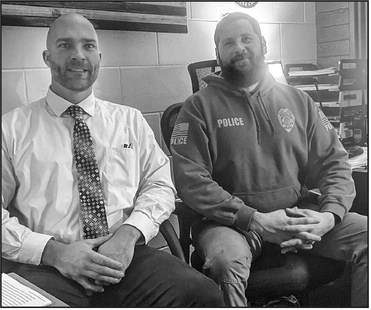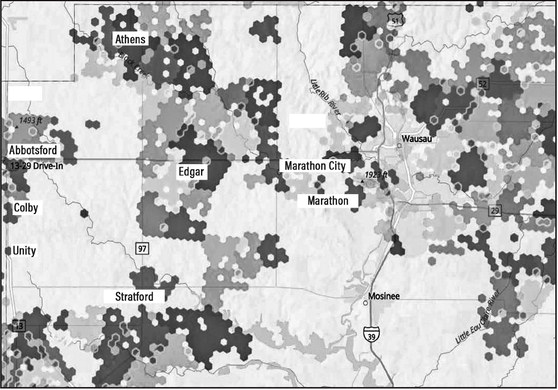Deportation fears hit Abby area


By Kevin O’Brien
As the new Trump administration rolls out mass deportations, local officials are trying to reassure immigrants in the Abbotsford area that their top priority continues to be serving and protecting all residents, regardless of immigration status.
“Yes, we do have a lot of people who are in our jurisdiction illegally,” said Colby-Abby police chief Alex Bowman during an interview Tuesday. “But it’s important for them to know that we are not the federal government.”
Still, it’s clear that the fear of deportation has grown substantially since President Trump returned to the White House on Jan. 20 and started signing executive orders calling for more aggressive deportation efforts nationwide.
Ryan Bargender, superintendent of the Abbotsford School District, said he knows of at least one family that pulled their children out of the district and said they were moving back to Mexico. He said both staff members and families in the district are worried about what could happen to them if they are caught up in a deportation sweep.
Concerns were ratcheted up after Trump rescinded a policy that prevented agents from Immigration and Customs Enforcement (ICE) from entering schools, churches and hospitals to arrest suspected illegal immigrants.
On Tuesday, the district sent out an email to parents letting them know that district staff is being briefed on their responsibilities and protocols in the event of an ICE enforcement action.
“As always, the safety and wellbeing of our students is our number one priority,” he wrote. “We support and are inclusive of all students, staff, families, and community members. We take seriously our responsibility to provide safe, non-discriminatory, and inclusive environments for all people.”
When asked what would happen if ICE agents showed up at the district, Bargender said the office staff would direct the agents to him and he would “vet them out.”
“Really, we just want to ensure our school is a safe place, and that our learning environment is not interrupted,” he said.
Bargender and Bowman sat down for a joint interview on Tuesday to discuss the local impacts of the Trump administration’s vow to remove millions of undocumented immigrants from the country.
As a local police chief, Bowman said he is limited in what he can do to enforce federal immigration law, especially when it comes to most routine traffic stops and other complaints.
“We can’t check someone’s immigration status on the side of the road,” he said. “I can’t tell if they’re here legally or not. We can make an assumption because a lot of people who are here illegally don’t have driver’s licenses.”
Even if a local officer suspects someone of being in the country illegally, he said they can only verify that if ICE has an active warrant out for the person. Otherwise, if the person is taken into custody and brought to jail, Bowman said it’s up to the corrections officers to run their fingerprints through a federal database to see if they are flagged for deportation.
Bowman said he can only think of two or three times when he’s successfully reached out to ICE to have them remove someone who has committed “heinous crimes.” One example he gave involved a Guatemalan immigrant who was stalking a woman and was repeatedly arrested before breaking into her house and threatening her with a gun.
This happened during the Biden administration, he noted, and it was difficult at that time to get ICE to take action.
“I had a very hard time trying to get a hold of Immigration, but I knew that was the best approach to get this individual out of here,” he said. “I could keep arresting this person over and over again, but he was going to keep coming back into our community.”
The 287(g) option
One option for more aggressive immigration enforcement on the local level is ICE’s 287(g) program. It allows local law enforcement agencies and sheriff’s departments to enter into an agreement with ICE so that local officers and deputies can help enforce federal immigration laws. One of the executive orders signed by President Trump last week calls for expanding the 287(g) program, which, as of last month, had about had 135 local police agencies enrolled across the country, according to ICE’s website.
Seven sheriff’s departments in Wisconsin currently participate in the 297(g) program, including those in Brown, Fond du Lac, Manitowoc, Marquette, Sheboygan, Waukesha, and Waushara counties.
Marathon County Sheriff Chad Billeb, however, does not believe it is justified for his department to join this program, based on the number of people they detain on an annual basis.
“This is a very small number, and there likely isn’t value in having a dedicated program at this time,” he wrote in an email in response to questions.
Chief Bowman said signing an agreement with ICE could allow CAPD members to be trained as “warrant service officers,” but that would only enable them to do the administrative work involved with ICE warrants. Officers can already detain suspects without that extra training, he noted.
“We just don’t have the time and money to invest in that,” he said.
While the sheriff’s department has not entered into a formal agreement with ICE, Billeb said it has had a good working relationship with the federal agency for many years.
“In essence, when someone is brought to our jail, arrested for a crime and who is in the country illegally, we notify ICE of the arrest and the charges the person is facing,” he wrote. “In many cases, this is completed through the fingerprinting process. ICE then makes a decision on whether or not a detainer will be placed.”
An ICE detainer is a request to hold an individual for up to 48 hours past their release date, which gives the agency time to decide if it wants to take that person into federal custody for possible deportation.
“What happens from there can vary,” Billeb wrote. “ We will continue this practice.”
When asked if the sheriff’s department automatically contacts ICE if a deputy pulls someone over or otherwise has contact with an individual suspected of being an illegal immigrant, Billeb wrote: “The answer to that is, generally, no. If we happen to run someone’s information and they show a warrant or a detainer by ICE, we may hold that person or contact ICE for a disposition.”
“It is important to understand that local law enforcement does not have the authority or jurisdiction to arrest or detain someone based solely on their immigration status,” he added.
Chad Billeb
TIME TO TALK - Ryan Bargender, left, superintendent of the Abbotsford School District, and Alex Bowman, chief of the Colby-Abbotsford Police Department, met Tuesday morning in Bowman’s office to discuss the local impact of President Trump’s executive orders targeting illegal immigrants. STAFF PHOTOS/KEVIN O’BRIEN



